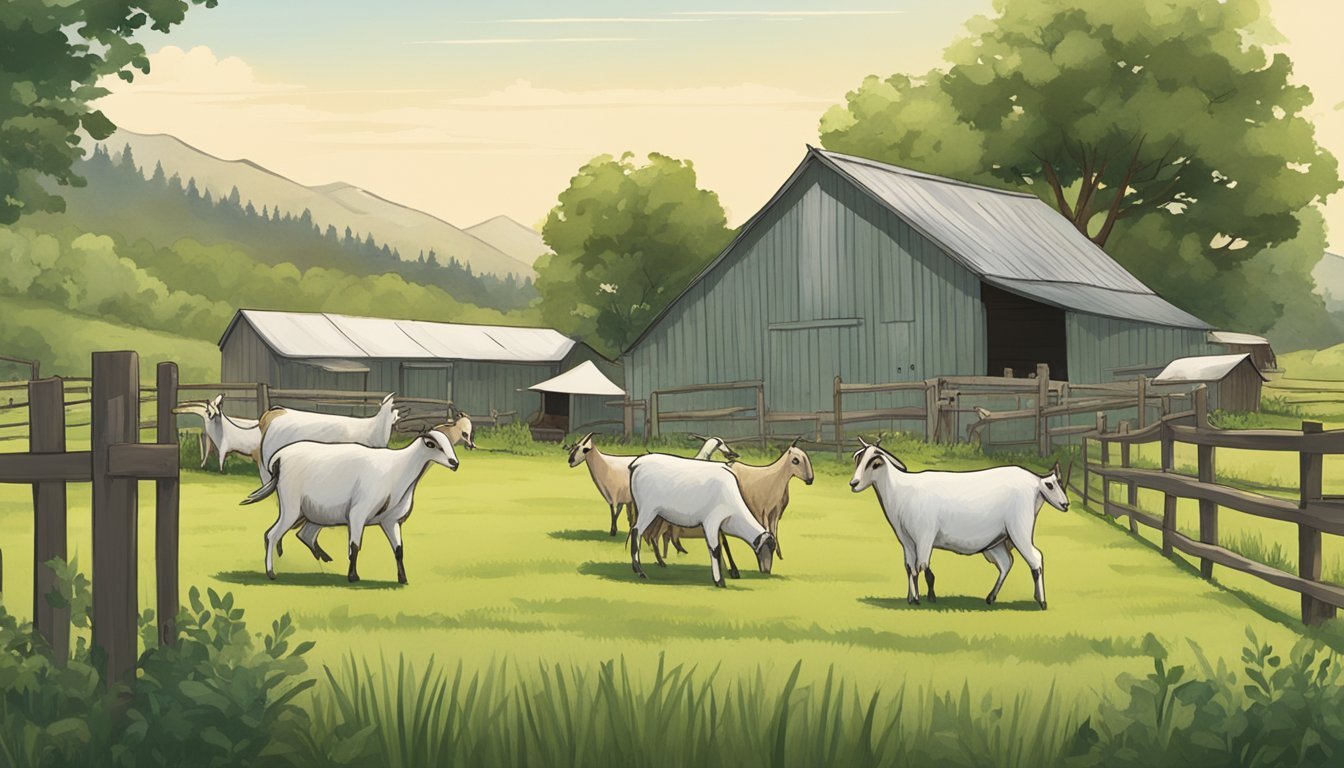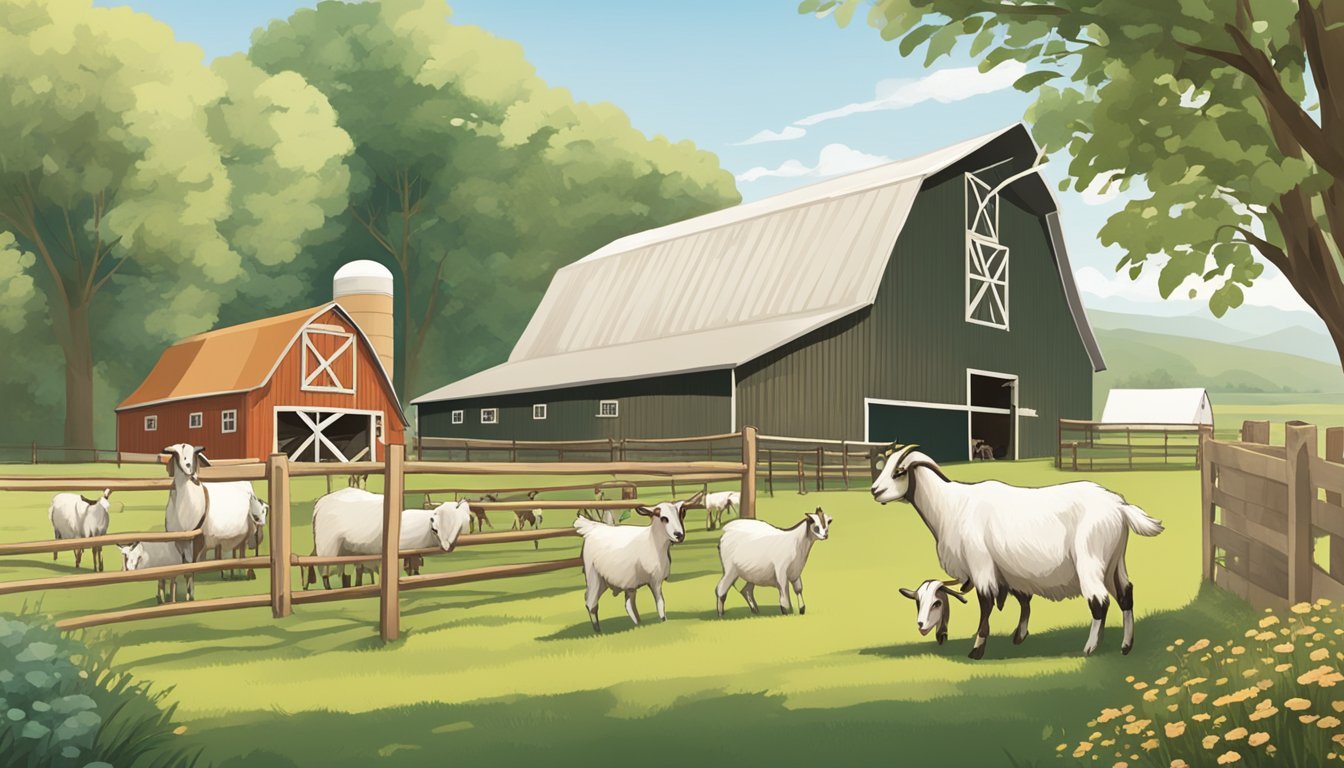How to Start a Goat Milk Co-op in Your Community
A Step-by-Step Primer
Starting a goat milk co-op can be a viable way to collectively market a unique and nutritious product while fostering a sense of community. Goat milk is appreciated for its digestibility and has a long history of consumption worldwide. In setting up a co-op, members can share resources, knowledge, and responsibilities, making it easier to navigate the challenges of small-scale dairy production. Forming a co-op requires detailed planning and a clear understanding of the cooperative model—where members are both suppliers and owners, participating democratically in decision-making processes.
To initiate a goat milk co-op, it is critical to assess the interest and commitment level within the local farming community. Engaging potential members in open dialogues about goals, expectations, and contributions is essential for laying a strong foundation. Leveraging resources like a step-by-step guide on how to start a co-op provides insightful information on structuring the business plan, conducting feasibility studies, and sourcing legal counsel to navigate the necessary paperwork.
Equally important is the understanding of regulations surrounding the production and sale of goat milk and dairy products, which can vary from one region to another. Ensuring that the co-op adheres to these regulations, including licensing and food laws, helps in creating a sustainable business framework and protects the health of consumers. With careful planning and clear legal guidelines, a dairy goat farming business can become a thriving community asset, offering local, fresh goat milk and potentially other goat milk-based products.
Understanding Goat Milk Production
Before diving into starting a goat milk co-op, it's crucial to comprehend the intricacies of goat milk production, including its benefits compared to cow milk, the different breeds suited for dairy production, and the vital aspects of goat care.
Benefits of Goat Milk Over Cow Milk
Goat milk is often celebrated for its digestive friendliness due to smaller fat globules and higher levels of medium-chain fatty acids. Rich in calcium and essential nutrients, it is a great alternative for those with sensitivities to cow milk. Furthermore, goat milk’s creamy texture and unique flavor have garnered a dedicated following, making it a lucrative focus for a co-op.
Overview of Dairy Goat Breeds
Several breeds excel in milk production, each with distinct characteristics:
Alpine: Known for their consistent milk output, Alpines produce a high volume of milk with a moderate butterfat content.
Nubian: Nubians offer milk with a high butterfat percentage, ideal for rich dairy products.
Nigerian Dwarf: These smaller goats are prized for their high butterfat milk, making it excellent for cheese and soap production.
Selecting the right breed is a strategic decision based on the desired end products of the co-op.
Essentials of Goat Care
To ensure optimal milk production, addressing the essentials of goat care is non-negotiable. Proper feeding is paramount, with a diet that includes forage and a balanced grain ration proportionate to milk yield. Housing should provide protection from the elements and allow for free movement. As for breeding, maintaining a healthy herd requires careful selection of bucks for mating and monitoring of wethers as they can influence herd dynamics. Regular veterinary checkups and adherence to sanitary milking procedures will safeguard the production of high-quality raw goat milk.
Setting Up Your Goat Farm
When considering the establishment of a goat milk co-op, the initial step is setting up a well-considered goat farm that ensures the well-being of the goats and efficiency of operations.
Selecting the Ideal Location
For a successful dairy goat farming operation, selecting the appropriate location is crucial. One needs to consider factors like climate, topography, and accessibility. The chosen site should provide an environment conducive for goat health and well-being, with sufficient space for grazing, as goats require plenty of room to browse and forage.
Infrastructure and Fencing Requirements
Robust infrastructure is pivotal in protecting and managing the herd:
Housing: Must be dry and ventilated, providing shelter from weather extremes.
Milking Parlor: A clean, organized space for the safe and efficient milking of goats.
Fencing: Strong to prevent escape or injury, and consider predator control measures.
Proper fencing is vital to safeguard the herd and support efficient grazing management:
Electric or woven wire fencing is often recommended due to goats' climbing tendencies.
Include sheltered areas within fenced paddocks to offer protection against weather.
Acquiring a Healthy Goat Herd
Starting with a healthy goat herd sets the foundation for a productive goat milk co-op. Key considerations include:
Conformation and Breed: Choose breeds known for milk production, such as the Nubian or LaMancha, with attention to good conformation.
Health Status: Ensure all goats are healthy with up-to-date vaccinations and free of diseases. Regular veterinary check-ups are a must to maintain herd health.
In conclusion, a well-planned goat farm requires careful consideration of location, infrastructure, and the acquisition of a healthy, well-bred goat herd to ensure the success and sustainability of a goat milk co-op.
Developing Co-op Business Strategies
When starting a goat milk co-op, crafting a thorough business strategy is crucial. This strategy should encompass a clear business plan, an understanding of the legal terrain, and robust financial planning to ensure the enterprise's viability.
Creating a Solid Business Plan
A business plan serves as a roadmap for the co-operative. It should detail the objectives, the structure of the co-op, and the operational plans for producing and distributing goat milk. The plan needs to outline each stage from milk production to market, including the scale of operation and potential market channels. Emphasizing the feasibility study can help validate the business model and attract investors or partners.
Understanding Legal Requirements and Certification
Navigating the legal requirements is imperative for setting up a goat milk co-op. This includes registering the co-op, understanding dairy laws, and meeting health standards through regular inspections. Certifications can add value to the products; for instance, obtaining organic certification or adhering to Good Agricultural Practices (GAPs) can appeal to certain markets. They should engage with a legal counsel well-versed in agribusiness to ensure compliance.
Budgeting and Financial Planning
A detailed budget is the backbone of financial planning. This budget should cover initial setup costs, ongoing operational expenses, and contingency funds. It's useful to project financial statements to anticipate cash flow, which is critical for maintaining a solvent operation. Additionally, they may consider different funding sources, such as grants, loans, or member investments, to ensure adequate capital for the co-op's activities.
Milking and Dairy Product Processing
Efficient milking processes and adept dairy product processing are the cornerstones of a successful goat milk co-op. Adhering to best practices ensures high-quality milk and dairy products such as cheese, butter, yogurt, and ice cream.
Setting Up Milking Processes
One begins by establishing a clean and systematic milking routine. It is crucial to use clean equipment and to wash the goats' udder and belly area before collecting milk to reduce the risk of contamination. Prompt refrigeration is necessary to inhibit the growth of pathogens. A solid structure, usually a milking stanchion, accommodates the goats during milking, enhancing safety and efficiency.
Equipment and Techniques for Dairy Products
After milking, processing into various dairy products requires specific equipment and techniques. For cheese, a cheese press and aging equipment are essential. To make butter, one needs a butter churn, while yogurt makers control the fermentation of yogurt. Ice cream, often an attractive product for co-ops, demands a freezing and mixing system. Each product must adhere to proper storage temperatures and conditions to ensure quality and safety.
By maintaining strict hygienic conditions and using the right equipment, a goat milk co-op can provide an array of wholesome dairy products to the community.
Marketing and Distribution
Effective marketing and distribution are critical for launching a successful goat milk co-op. This entails crafting a compelling brand identity, fostering connections within a community food co-op network, and strategically overseeing the channels through which products reach consumers.
Branding and Promotion Strategies
To distinguish a goat milk co-op, branding is essential. The brand should reflect the quality and health benefits of goat milk, aligning with consumers' desire for healthy food options. Promotion strategies can include social media campaigns, farmers' market attendance, and local partnerships. A consistent message that emphasizes the community and health-driven nature of the co-op's products will help build trust and loyalty.
Social Media Campaigns: Utilize platforms like Facebook and Instagram to showcase products and behind-the-scenes farming operations.
Farmers' Market: Regular booths at local markets can introduce products directly to consumers.
Local Partnerships: Collaborate with local health food stores and restaurants to broaden the distribution network.
Building a Community Food Co-op Network
Organizing a network of food co-ops enhances resource sharing and mutual support among local food initiatives. Establish relationships with existing co-ops to cross-promote products and share best practices for managing food co-ops. Networking events and joint initiatives can bolster the profile of all involved, creating a robust community food system.
Cross-Promotion: Create mutual referral systems between co-ops.
Networking Events: Attend and host events to build a solid community presence.
Managing Distribution Channels
Effective distribution management ensures that the goat milk reaches consumers through various channels. This could include direct-to-consumer sales, online ordering systems, and establishing a presence in community food stores. Each channel should have defined logistics, from transportation to stocking, to maintain product integrity and freshness.
Direct-to-Consumer Sales: Implement farm pick-up options or home delivery services.
Online Ordering Systems: Develop a website or partnership with online marketplaces to capture broader market segments.
Community Food Stores: Secure shelf space in local stores, emphasizing the local, healthy origin of the co-op's goat milk.
By focusing on these marketing and distribution strategies, a goat milk co-op can establish a recognizable brand, foster connections within the community, and ensure efficient delivery of high-quality products to consumers.
Membership and Community Engagement
Successful goat milk co-ops rely on clear structure and active community participation. Building a solid membership base and engaging with the community through education and outreach are critical for a thriving cooperative environment.
Creating a Waiting List and Membership Process
To manage demand and maintain high-quality service, a goat milk co-op should establish a waiting list. As interest grows, this list will help the producers manage their farms effectively, ensuring each member receives a consistent supply of goat milk. The membership process must be transparent, showing potential members how the waiting list operates. Producers may prioritize local community residents to foster a sense of investment and belonging. This also ensures that the co-op's offerings are accessible to those with a genuine passion for supporting local agriculture and a shared experience in dairy cooperative initiatives.
Initial Steps:
Collect contact information.
Provide estimated wait times.
Revise waitlist as memberships open.
Membership Approval:
Application review.
Possible farm visit or interview.
Membership fee payment and agreement signing.
Educational Programs and Community Outreach
A well-informed member base contributes to the co-op's stability. Offering educational programs can enrich members' knowledge about the benefits, processes, and responsibilities involved in a goat milk cooperative. These programs not only engage members but also serve as a tool for community outreach, attracting new members and fostering a grounded relationship with the community. Host farm tours, cheese-making workshops, and talks on sustainable agricultural practices to ignite members’ passion for goat milk products and the co-op's underlying values.
Offerings:
Monthly farm tours and meet-the-goats events.
Workshops on cheese-making, yogurt production, and more.
Informative sessions on the nutritional benefits of goat milk.
By focusing on these aspects, a goat milk co-op can effectively organize its membership and community engagement, laying a strong foundation for a connected and enthusiastic cooperative culture.
Innovative Opportunities and Trends
The goat milk industry is ripe with innovative opportunities and trends, particularly in organic and artisanal product development and the exploration of alternative goat products. These initiatives cater to the growing consumer demand for sustainable and unique dairy alternatives.
Organic and Artisanal Product Development
The shift towards organic goat milk products reflects consumers' increasing interest in health and environmental welfare. Producers can capitalize on this trend by offering organic goat cheese or chevre, which appeals to those seeking higher protein and lower cholesterol options. Additionally, the popularity of artisanal goat milk products like yogurt and kefir is surging, presenting more niche market opportunities. By focusing on small-batch, high-quality products, co-ops can distinguish their offerings in the market.
Exploring Alternative Goat Products
Beyond traditional dairy, goat co-ops have the chance to diversify into other products like goat meat and goat milk soap. Both are emerging as sustainable alternatives to conventional options, with goat meat being a lean and nutritious choice and goat milk soap recognized for its gentle and beneficial properties for skin health. Moreover, the sale of raw milk directly to consumers presents an opportunity, although it must be approached with careful adherence to legal regulations and health standards. This can attract a base of consumers who prefer minimally processed foods.
Challenges and Solutions
Starting a goat milk co-op can be an enriching endeavor but comes with its unique set of challenges. Ensuring a clear understanding of these challenges and corresponding solutions is crucial for a successful cooperative.
Addressing Common Challenges in Goat Dairying
Goat dairying faces several challenges that may hinder the initiation and growth of a cooperative. One prominent challenge is the supply of grains, which can fluctuate in price and availability, impacting feed costs. To manage this, co-ops can bulk purchase grains or explore alternative feed options to ensure stability while potentially reducing costs.
Another challenge is the public perception of goat milk, which is not as widely accepted as cow milk. Education campaigns and taste testing events can demonstrate the health benefits and culinary versatility of goat milk, potentially increasing consumer demand.
Finding Solutions for Sustainable Co-op Growth
For a goat milk co-op to grow sustainably, they must implement solutions that streamline operations and enhance marketing efforts. One solution includes investing in efficient milking and processing equipment to increase productivity and maintain high-quality standards.
Furthermore, establishing a strong network with local businesses and restaurants can foster a reliable market for goat milk products. Offering membership benefits, such as dividends and discounts, can also incentivize community involvement and investment in the co-op, strengthening the cooperative model.
Conclusion
In establishing a goat milk co-op, community involvement and support are fundamental. Producers benefit from a cooperative model through shared resources, combined marketing efforts, and stronger bargaining power for better pricing. It encourages local economic growth and sustainability by connecting farmers directly with their local consumer base.
Producers should adhere to best practices in goat milk production, ensuring quality and safety. They must also comply with the relevant dairy licensing and food laws, as these regulations govern commercial sales. Engaging with established goat milk producers can offer invaluable insights and serve as a mentorship opportunity for new farmers. For more information on best practices and legal considerations, interested parties can refer to Starting a Dairy Goat Farming Business Plan.
Co-op members play a crucial role in educating the community about the benefits of goat milk. They should collaborate to create a business plan that reflects their shared goals and outlines the operational structure of the co-op. Equipped with a robust plan, they are more likely to attract funding and community support.
Community support is paramount for the success of a goat milk co-op. Public awareness campaigns and tasting events can help in garnering interest and increasing goat milk's acceptance as a viable alternative to cow milk.
In summary, the co-op's success hinges on collective effort, adherence to regulations, educational outreach, and strong community relationships. With these foundations, a goat milk co-op has the potential to thrive and contribute positively to local food systems.






